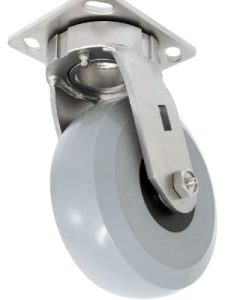 When designing a heavy-duty cart, calculating the load capacity isn’t as simple as dividing the total weight by four. Towing, dynamic loads, and the caster setup you choose—like center rigid vs. corner swivels—dramatically impact the safety and lifespan of your equipment.
When designing a heavy-duty cart, calculating the load capacity isn’t as simple as dividing the total weight by four. Towing, dynamic loads, and the caster setup you choose—like center rigid vs. corner swivels—dramatically impact the safety and lifespan of your equipment.
This technical guide will walk you through the essential calculations and design choices to ensure your four-wheel cart is up to the job.
Step 1: Calculate the Essential Load Capacity
The industry standard for a four-caster setup is to assume that only three casters will be carrying the load at any given time. This compensates for uneven floors, bumps, and other inconsistencies.
The Formula:
{Required Individual Caster Capacity} Total Weight of the cart plus the load X Safety Factor of 1.5 and divide by 3 = Required Individual Caster Capacity
- Total Weight: This is the combined weight of your empty cart plus the maximum weight you plan to carry.
- Safety Factor (The Crucial Part): For manually pushed carts, use a factor of 1.25 to 1.5. For towed carts or carts subject to heavy impact, you must use a higher factor, generally 1.5 to 2.0.
Example: A towed cart with a maximum load of 6,000 lbs.
6,000 lbs. x 1.75 divided by 3 = 3,500# capacity per caster.
To handle this load safely, you would need casters rated for at least 3,500 lbs. each.
Step 2: Factor in Towing and Dynamic Loading
When a cart is towed, the forces applied—starting, stopping, and turning—are significantly higher than in manual operation. This is called dynamic loading.
- Impact on Capacity: The sudden jolt of a tow hitch start or a rapid stop can momentarily triple the effective weight on the leading casters. This is why the higher Safety Factor (up to 2.0) is mandatory for towed applications.
- Wheel Material: Towed carts should utilize high-capacity, durable wheel materials like polyurethane on cast iron or poly on aluminum. Softer materials like rubber or pneumatic wheels often generate too much heat or suffer catastrophic failure under continuous high-speed towing.
- Bearing Selection: For any towed application, precision ball bearings are critical. They handle higher speeds and continuous use with far less resistance and wear than typical roller bearings.
Step 3: Optimizing Your Caster Pattern for Heavy Loads
The layout of your casters affects stability, maneuverability, and ease of pushing. For heavy-duty applications, two patterns are common alternatives to the standard four-swivel setup:
- The Two Rigid, Two Swivel Setup 🔄↔️
This is the most common heavy-duty setup. The two rigid casters are placed at one end (often the “push” or “tow” end), and two swivel casters are placed at the opposite end.
Pros: Excellent directional control. The cart tracks straight and is much easier to steer than an all-swivel cart.
Cons: Less maneuverable in tight spaces (no rotation around its center).
- The Center Rigid Pattern (Tilt-Type) 🔺
This setup uses four swivel casters mounted at the corners, but it also incorporates two larger, rigid casters mounted in the center of the cart. The center rigid casters have a slightly larger wheel diameter (usually 1/8″ to 1/2″ larger) than the swivel casters.
How It Works: The cart rests on the two large center rigid wheels and two of the smaller corner swivel wheels at any given time. This creates a seesaw action, allowing the cart to be tipped and pivoted on the center casters, giving it superb maneuverability while still tracking straight for long-distance towing.
Best For: Extremely heavy loads, long towing runs, and environments requiring excellent pivoting ability.
Safety Beyond Capacity: Brakes and Swivel Locks
Once you have the right load rating and wheel material, ensure you can stop and secure the cart.
We can fit brakes or swivel locks on virtually any caster type to enhance safety and operational control:
- Total Lock Brakes: These simultaneously lock both the swivel raceway and the wheel, immobilizing the entire cart. Essential for loading docks or incline environments.
- Wheel Brakes: These simply lock the wheel tread, allowing the caster to still swivel but preventing movement.
- Directional Swivel Locks: These convert a swivel caster into a rigid caster (usually 4-position locking), perfect for improving tracking during long-distance towing without sacrificing tight-space maneuverability.
Don’t compromise on safety. Calculating your load capacity correctly, factoring in dynamic forces from towing, and choosing the right caster pattern are the keys to a durable and high-performing heavy-duty solution.
Need help with your heavy-duty design? Contact our engineering team today for a full application review.
